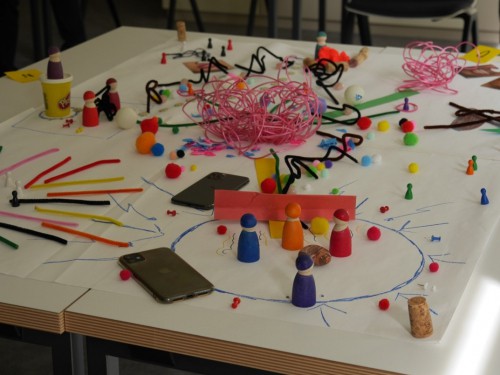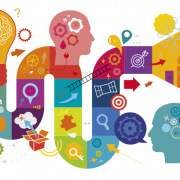Creating the future with 3D mapping
26.11.2021
The current time requires constantly to deal with challenges and to deal with change. There are many forms of facing these topics. Most of these formats are very rational. With 3D mapping, a completely different approach is practiced: in a creative and intuitive way, approaches to solutions are found and developed. Creating the future with the help of 3D Mapping.
And what exactly is 3D mapping?
An organizational development method created by the Presencing Institute and used primarily by teams dealing with change and challenges. 3D Mapping provides the ability to visually map a system or issue or idea and look at how it might evolve from multiple dimensions and perspectives.
The strength of this method lies in the fact that participants think out of their heads, work with their hands and create a model together. One does not think about the current situation and its possible development.
In a creative and intuitive development process the image of “reality” is created. If the knowledge of one’s own hands is trusted, one does not fall back into habitual ways of thinking about the present and imagine the future as a continuation of the existing, but it is very likely that new ways will be discovered. And that is exactly what creating the future with the help of 3D mapping is.
Creative techniques are used and different creative materials are employed. At first glance, it looks a bit like a DIY session, but it is an innovative method that has long since gained recognition in the business world. At the latest after Design Thinking has conquered the stage.
3D Mapping in 3 steps
Before ideally 4-7 participants start creating the model of their system or their issue, it is made clear what the intention is and what the focus of the mapping is.
The first step is then to create a mapping that represents the current state of a system. Each object in the model represents a different element, quality or stakeholder of the system.
In the second step, team participants reflect on the model from four different perspectives and with different questions. This gives the participants the opportunity to each develop a different view of the existing system from a different archetypal perspective.
In the third step, the participants design the future based on the insights gained. To do this, they change the model in such a way that it better represents the new future they want to bring into the world.
Afterwards, the overall process is reflected upon and measures can be derived to solve or redesign the problem. As a rule, these measures are characterized by the fact that they get to the point and prioritize themselves immediately. In addition, there is no need to call in a committee of implementers. This has already been done in the process.
That’s probably why this method is so powerful. It is sustainable.
An example: 3D mapping in a nursing facility
A few weeks ago, we implemented this process of 3D mapping with the care management team of a nursing facility. It was incredible to see the emotions that immediately come into play when this format is used. We experienced emotionally heavy moments, but also very touching ones.
The members of the team got into a good flow very quickly when creating the model and, without consulting each other, created the current situation in an intuitive and creative way.
For us as process facilitators it was nice to observe how the people in this team trusted each other, worked together and protected and supported each other. Thus, there was a necessary stability to create what emerged.
The process starts with an AS IS picture
When the work began, the energy in the room changed noticeably, it became visibly heavy and oppressive. This energy was also reflected in the model: Although the good unity of the team members was evident here as well, heaviness and chaos dominated in many places. Many walls, demarcations, no cooperation. On the contrary, in many areas there was a recognizable counteraction and watching each other.
When the team members reflected on the model, everyone was quickly aware that a change had to be made promptly. One statement was “if you look at the model longer, you would like to run away”. This statement sums up the image and energy in the room well. However, there were also statements of encouragement. In reference to the leadership team, the terms “love” and “our unity” fell; in reference to the nursing facility, the potential and spirit of the home was emphasized.
After creating the current situation and reflecting on the model, the leadership team was mentally and physically exhausted. This was a completely normal process, as they had been very intensively involved in this process. We paused here in the process and did not design the future model until two more weeks had passed. This allowed the team members to reflect on the process again in peace, to gain some distance and to shape the future with fresh energy.

3D Mapping process
The second step is about future
At the beginning of the second session, experiences and insights from the first session were reflected upon once again. Afterwards, the team members set about designing the future with great enthusiasm.
Very quickly they were back in the flow. And without any consultation, one change after the other was made to the model. What a difference it was from the last time!
A lot of lightness unfolded in the room. A very light energy and love were noticeable, the true spirit of the house spread. There was nothing of the leaden heaviness of the last time, which also affected the team members. The team energized and motivated. And for all to see the weight that had fallen from the shoulders of the team members and how a breath of fresh air could take place. That was constructive and effective future design with 3D mapping.
The presented future shows a picture of understanding and togetherness. Looking at the model, the team members were able to quickly develop initial ideas on how to achieve this future. They are very optimistic and motivated to create this ideal image together – with the nursing staff – and to make the house a unique place for the residents and relatives.

3D Mapping process
For us, it was a fulfilling task to be able to support the nursing management team in finding a way to shape the future and we are also pleased to be able to accompany them for a while.
Want to know more about 3D mapping process?
Please contact us.
This case was written by Julia Winkler.









